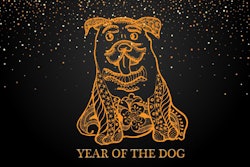
Chefs with Campbell’s Soup compiled a list of human food trends that they expect to see break out in 2019. While the chefs forecast these trends for people’s plates, history shows that similar products may be popular in pets’ bowls as well. Campbell’s Trendscape ranked the ingredients according to their level of acceptance in human cuisine.
-
Mushrooms and other fungi in human and pet foods
Mushrooms are nothing new on human plates, but chefs think fungi will appear in more places and in a wider variety in 2019. Several reasons backed up their prediction. For one thing, some varieties of mushrooms have medicinal or healthy reputations, so they meet demands for functional ingredients. Similarly, mushrooms can serve as the base for non-meat snacks, which scores points with vegetarians, vegans and flexitarians. Campbell’s chefs ranked mushrooms as an introductory phase trend.
Considering that both functional ingredients and meat alternatives are gaining traction in pet food, mushrooms and other fungi may pop up in more pet products as well. In 2018, one company, Wild Earth, began using the fungus Aspergillus oryzae, known as koji, in dog treats, but they face regulatory and consumer acceptance challenges similar to those of other novel ingredients. Koji boasts a long history in East Asian human diets, but it is a newcomer to the pet food scene.
-
North African foods, spices and ingredients in human and pet foods
North African foods, spices and ingredients may burst into the mainstream in 2019, according to Campbell’s chefs. In general African foods and ingredients have been growing in popularity, including piri piri, berbere spice, urfa chile, teff, and superfoods like baobab and moringa. North African flavors were classed as an introductory phase trend.
North African cuisine may be the next in a long line of regional styles to take the human foodie world by storm, which means it may filter into pet diets soon too. Pet food companies have certainly noticed people’s love for regional recipes. At SuperZoo 2018, various new pet foods and treats styled after regional cuisines were on display. However, North African ingredients seem to be largely uncharted territory for pet foods and treats.
-
All-day dining for people and pets
Traditional definitions of breakfast foods versus dinner and lunch entrees have loosened, and mealtimes themselves seem to be following suit. Campbell’s chefs noted that people already demand meals that fit at any time of day, as well as any level of hunger. Chic restaurants and cafés increasingly offer dishes that serve for breakfast, brunch, lunch, dunch, dinner or what-have-you. The all-day dining trend ranked as an adoption phase trend.
Of course, pets are ahead of the game on this one. Many dogs and cats have bowls set out, which then stay there until they finish, and the food within those bowls is generally the same regardless of time of day. However, when those bowls run empty, an increasing array of automatic dog and cat feeders make sure pets can eat, regardless of owners’ schedules. So, cats never have to miss brunch, even if it lacks bottomless mimosas.
-
Next-level texture in human and pet foods
Beyond flavor, people increasingly want a nuanced texture to their food. Campbell’s chefs see the rise in novel textures as an adoption level trend. Items like crispy noodles, flaked chocolate, popped sorghum and even 3-D printed foods exemplify this texture trend.
Texture plays an important role in pets’ food experience as well. What’s more, pet owners consider texture important. For example, David Sprinkle, publisher and research director at Packaged Facts, wrote in Petfood Industry that pet owners tended to believe kibble provides oral hygiene benefits to pets as they crunch on the hard pieces, reasoning that the abrasion may help clean pets’ teeth, despite limited evidence that hard kibble alone provides significant dental benefits.
Besides believing that texture has dental health effects, pet owners may believe texture plays a role in keeping pets’ interested in their food. A survey by Wellness Natural Pet Food found that 70 percent of respondents wonder if their pet gets bored eating the same thing every day. The company stated that they aim to use texture, along with flavor, in toppers and mix-ins to increase variety in pets’ meals.
-
Novel vegetables in human and pet foods
Campbell’s chefs forecast that vegetables will continue to appear move out of the side dish shadows and onto center stage as main ingredients. The chefs classed vegetables as a mainstream trend, but with room to expand as novel veggies sprout on menus. Sea veggies and lesser known greens, such as celtuce, may become more popular in 2019.
Pets too will likely see more vegetable-based foods. Dog and cat owners’ increasingly want to see recognizable vegetable ingredients in wet dog and cat foods, said Jeroen Boensma, area sales manager at SELO Food Processing, during his presentation at Foro Mascotas 2018 in Guadalajara, Jalisco, Mexico.
As to which vegetables consumers want to see, certain nutrient-rich plants have gained popularity under the term superfoods, both in human and pet food, according to the Petfood Industry Knowledge Center. Although there’s no legal or medical definition of a superfood, these ingredients became especially popular in premium and superpremium pet food and treats. For example:
- Sweet potato – Sweet potatoes can now be found in pet food diets for the treatment of food hypersensitivities/allergies.
- Pumpkin - Pumpkin can be used in raw pet food diets as a fiber source to help alleviate constipation, which can be an issue when feeding raw pet food diets.
- Quinoa - These protein-rich seeds are gluten-free and grow in arid, harsh environments.
- Peas - Peas provide protein, vitamin A, thiamine, niacin, vitamin B6, folate, vitamin K, copper, zinc and manganese.
6. Wellness beverages in human and pet foods
To wash down their superfoods, people will want more beverages with functional ingredients. For example, kombucha has grown from a homemade hippie specialty to supermarket popularity. Kefir also exemplifies the established functional beverage trend.
For pet food, treat and now drink makers, various functional ingredients are moving from human diets into the pet foods, said Natasha Davis, client service manager for GfK, at Petfood Forum 2018.
- Turmeric - Turmeric has been used in pet food for years, but only appeared on the ingredient panel, she said. Now, turmeric is moving around to the front of the package.
- Coconut - Another ingredient that is migrating from the ingredient panel to the front of pet food packaging is coconut. In human products, coconut is touted as a beauty aid, weight-loss aid and hydration helper, she said. Similar claims have followed the giant seed into the pet food market.
- Honey - Davis asked, when you have a sore throat, what’s the first thing people recommend? Honey in water. Many human health and wellness, or biohacking, products use honey. Pet food products too now promote honey for sore throats along with other health benefits, while sweetening products naturally.

















